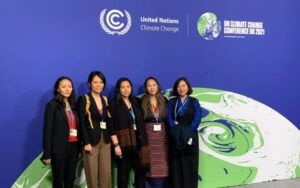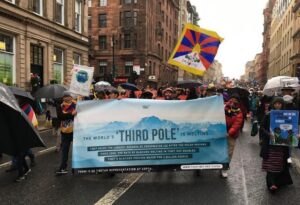
All-women team of Tibetan Environmentalists
Photo: Tibet.net
A team of Tibetan environmentalists are in Glasgow, UK, representing Tibet. They are urging world leaders gathered for the COP26 United Nations Climate Summit to make the Tibetan Plateau central to any global climate change discussion. They are highlighting the ecological importance of the Tibetan plateau as the world’s “Third Pole” and drawing attention to Tibet’s fragile ecosystem which is under threat from China’s exploitation of its resources.
The all-women team includes Dechen Palmo, a researcher from the Central Tibetan Administration (CTA)’s environment desk, Dr Lobsang Yangtso, Environmental Researcher and Asia Regional Coordinator at the International Tibet Network, Palmo Tenzin, Advocacy and Research Officer at the International Campaign for Tibet, Pema Doma, Campaigns Director at Students for a Free Tibet, and Tenzin Choekyi, Senior Researcher at Tibet Watch. They are collectively pushing for the protection of the world’s highest and most glaciated plateau. The team spoke to delegates at COP26 and have been participating in a number of side events, speaking about the environmental issues of the Tibetan plateau.
The CTA reports that the team was able to raise the issue of Tibet’s climate crisis with delegations from Bangladesh and South Africa. They metand briefed Scotland’s First Minister, Nicola Sturgeon, former United States Vice President Al Gore, Hollywood Actor and environmental campaigner Leonardo DiCaprio, and United States Special Presidential Envoy for Climate John Kerry. They handed out factsheets, 5-Point Call to Action for Tibet to prominent delegates and participants.
The 5-Point Call to Action for Tibet includes five demands to enable understanding of the issues, and for the protection of, the Tibetan plateau. The primary demand is “recognition of the global ecological importance of the Tibetan Plateau and need for its inclusion as a primary topic at global climate summits”.

Dr Lobsang Yangtso reaching out to Hollywood actor and climate change activist Leonardo Dicaprio at the COP26
Photo : Facebook
Dr Lobsang Yangtso (International Tibet Network) and Tenzin Choekyi (Tibet Watch) participated in the United Nations Framework Convention on Climate Change (UNFCCC)side event Achievements of the Facilitative working Group of the Local Communities and indigenous People by asking direct questions about the fact that Tibet’s glaciers are warming faster than the global average, posing a threat to the billions of Asians living downstream.
His Holiness the Dalai Lama published a message in advance to the climate delegations gathered for the summit saying, the “Tibetan plateau, the largest reservoir of snow and ice outside the North and the South Pole sis called the Third Pole and Tibet is the source of some of the world’s major rivers, among them the Brahmaputra, the Ganges, the Indus, the Mekong, the Salween, the Yellow River and the Yangtze. These rivers are the source of life because they provide drinking water, irrigation for agriculture and hydro power for nearly two billion people across Asia. The melting of Tibet’s numerous glaciers, the damming and diversion of rivers, and widespread deforestation, exemplify how ecological neglect in one area can have consequences almost everywhere”.
A report published by Radio Free Asia stated that Tibetan plateau is known among tourists as the “Roof of the World” and to scientists as the “Third Pole” because of the global significance of its glacial ice pack – a quarter of which has been lost since 1970, with more glaciers threatened to disappear by 2100.

Photo: Kate Murry
China’s exploitation of Tibet’s natural resources through logging, mining and dam-building has systematically undermined Tibetan traditions, culture and a lifestyle which has nurtured the environment for centuries. China’s activities in Tibet have devastated an ecosystem that supports a third of humanity as the source of Asia’s major rivers, said the RFA report. “China’s policy responses for climate change mitigation and adaptation undermine sustainable development and traditional livelihood sources on the Tibetan Plateau,” continued RFA, quoting the Tibetan Centre for Human Rights (TCHRD) report. “Relocating and resettling nomadic pastoralists from highlands to heavily surveilled urban fringes means an end to collective ownership of upper pastures as common pool resources managed by customary decision making,” they added.




 Print
Print Email
Email